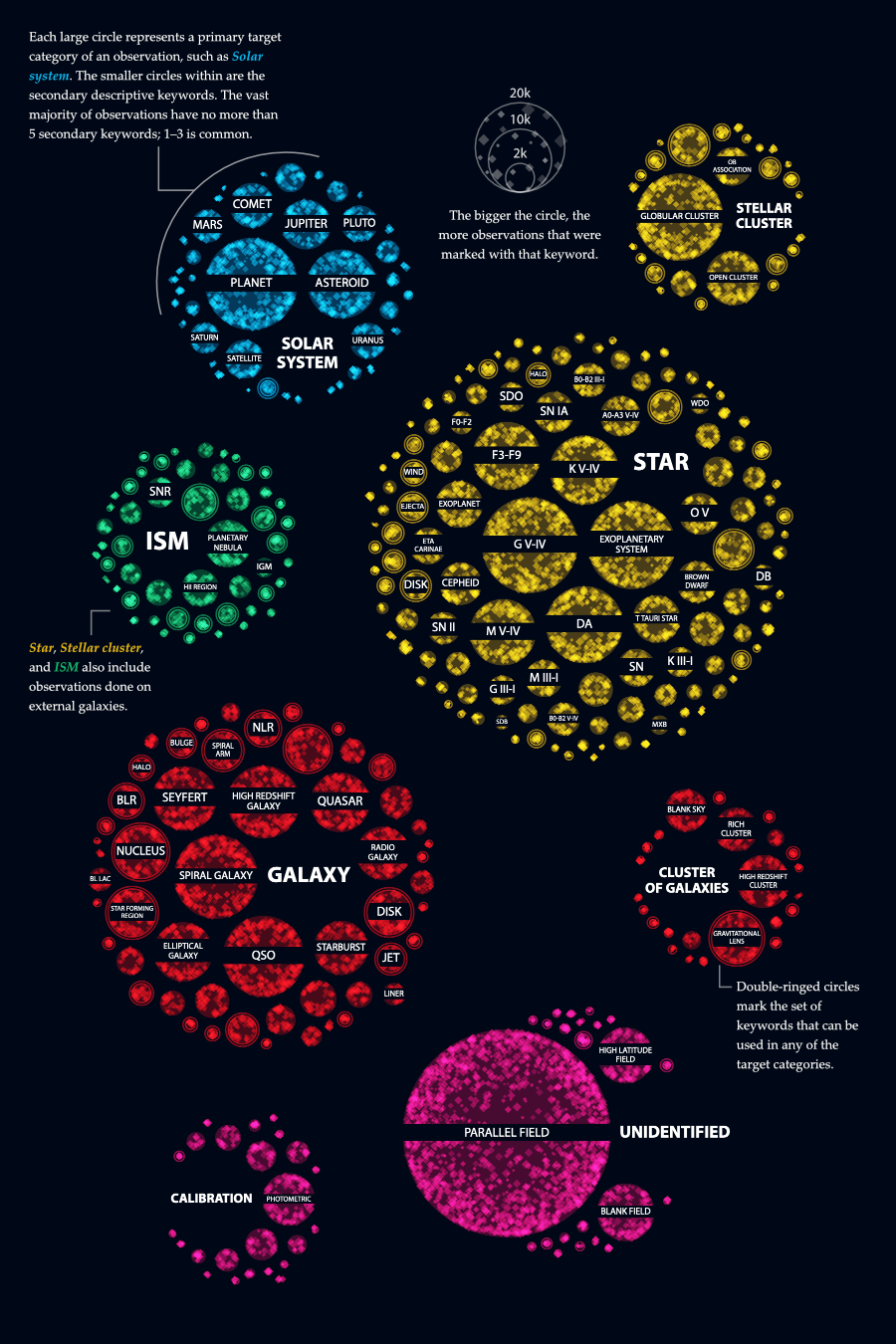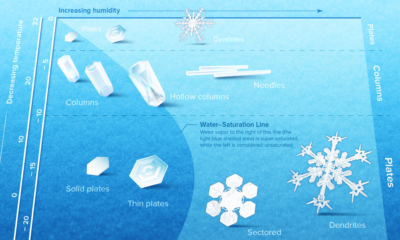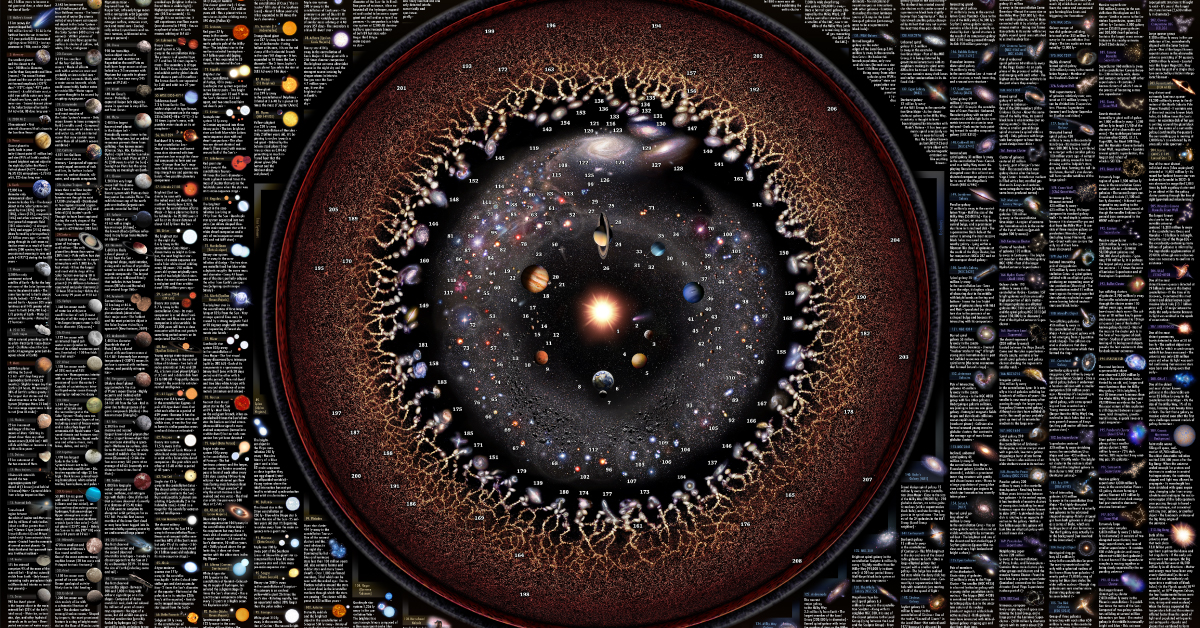We’ve been fascinated by space for centuries, but telescopes truly opened our eyes to what lies beyond our frontiers. For 30 years, the Hubble Space Telescope has been our companion in helping us understand outer space, paving the way for many important scientific discoveries in the process.
A Window to the Universe
Hubble launched on Apr 24, 1990 and has been in our orbit ever since. However, it had something of a shaky start. Due to an error in its primary mirror, it returned many wobbly and blurry images—until a servicing mission in December 1993 fixed the issue. Today’s incredible map was created by Nadieh Bremer of Visual Cinnamon, for the scientific journal Physics Today. It incorporates over 550,000 scientific observations, to show the diverse objects captured by Hubble between 1990-2019. Certain constellations have been included to help place these findings, many of which are also visible to the naked eye. Here are the main color-coded categories found on the map:
Yellow: Star/ Stellar cluster Example: V838 Monocerotis, which includes a red star and a light echo. Red: Galaxy/ Clusters of galaxies Example: Spiral galaxy M81, half the size of the Milky Way. Green: Interstellar medium (ISM) Example: Eagle Nebula, a majestic spire of cosmic dust and gas, resembling pillars and spanning 4-5 light years. Blue: Solar System Example: Jupiter’s Great Red Spot, a high-pressure storm in the planet’s atmosphere. Pink: Calibration/Unidentified (e.g. Hubble Deep Field surveys) Example: Ultra Deep Field, which captured a view of 10,000 galaxies over 11 days—some which date back to the early billion years of the universe.
NASA considers the Hubble telescope the “most significant advance in astronomy since Galileo’s telescope” and not without good reason—its total observations top 1.3 million.
Hubble Observations, by Category
The journey doesn’t end there, either. Bremer also looked at the frequency of Hubble observations that occurred within each of these categories, ranging from 1,000-20,000.
Source: Physics Today Each category encompasses multiple distinctive descriptions. For example, galaxies can be broken down further into whether they are spiral, nuclear, elliptical-shaped and much more.
Hubble’s Growing Legacy
The images sent back by Hubble over these three decades are not just for aesthetic purposes. The telescope is also responsible for immense contributions to the astronomy field: close to 13,000 scientific papers have used Hubble as a source to date. The biggest scientific breakthrough thus far? The realization that our universe is expanding at an accelerating rate—thanks to a force called dark energy. —Colleen Hartman, Former Deputy Center Director, NASA Goddard Space Flight Center It’s clear that Hubble already has an impressive legacy, and it’s not expected to be retired until at least the year 2025. Soon, it will be joining forces with the new James Webb Space Telescope, to be launched in March 2021. For the next generation of space enthusiasts, their eyes to the skies may well be the Webb instead. For the true data viz nerds among us, here is an in-depth blog post detailing the sky map’s creation from scratch. on And while we haven’t figured out all the answers quite yet, we’ve made some remarkable discoveries when it comes to learning about outer space. What are some of the most notable observations that scientists have discovered so far? This map of outer space by Pablo Carlos Budassi highlights more than 200 celestial objects in our universe and provides details and facts about each one.
The Types of Celestial Objects Mapped
To create this graphic, Budassi used a combination of logarithmic astronomical maps from Princeton University, as well as images from NASA. The visualization highlights 216 different celestial objects that are color-coded and organized into five overarching categories:
Moons and Asteroids Planets Galaxies Star System Great Scales/Superclusters
At the center of the map is the Sun, which is the largest object in our Solar System. According to NASA, the Sun’s volume is equivalent to 1.3 million Earths. The Sun is the powerhouse of life here on Earth—its energy provides our planet with a mild, warm climate that keeps us alive, keeping the Earth from becoming a frozen rock. While the Sun is the only star in the Solar System, there is a neighboring star system called Alpha Centauri that’s approximately 4.37 light-years away. It’s made up of three stars—Proxima Centauri, Alpha Centauri A, and Alpha Centauri B. Proxima Centauri, as the Latin name indicates, is the closest of the three to Earth and has an Earth-sized planet in its habitable zone.
The Life of a Star
In a star’s early stages, it’s powered by hydrogen. However, when its hydrogen stores are depleted, some stars are able to fuse helium or even heavier elements. Stars similar to the size of the Sun will grow, cool down, and eventually transform into a red giant. The Sun has about 5,000 million more years before it reaches its red giant stage, but when that happens, it will likely expand to the point where it swallows up the Earth. While stars emit energy for years, it’s important to note that they don’t shine for eternity. Their exact life span depends on their size, with bigger stars burning out faster than their smaller counterparts. But as light from distant objects millions of light-years away takes a long time to reach us here on Earth, the largest of stars shine for hundreds of millions of years after they die.
Just How Big is Our Universe?
Some experts believe that the universe is infinite, while others argue that we can’t yet know for certain because current measurements aren’t accurate enough. However, scientists believe that our observable universe extends about 46 billion light-years in every direction, giving it a diameter of roughly 93 billion light-years. But just how much of the universe extends beyond what we can see? We may never find out.














